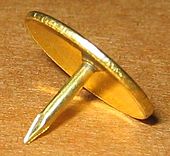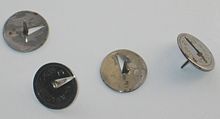Drawing pin


Adrawing pin(inBritish English) or [thumb]tack(inNorth American English), also called apush-pin,is a short, smallpinornailwith a flat, broad head that can be pressed into place with pressure from the thumb, often used for hanging light articles on a wall or noticeboard.
Thumb tacks made ofbrass,tinorironmay be referred to as brass tacks, brass pins, tin tacks or iron tacks, respectively.[1] These terms are particularly used in theidiomaticexpressionto come(orget)down to brass(or otherwise)tacks,meaning to consider basic facts of a situation.[2]
History[edit]
The drawing pin was invented in name and first mass-produced in what is now the United States in the mid/late 1750s; the earliest use of the term, Drawing Pin, is listed in theOxford English Dictionaryas 1812.[3]It was said that the use of the newly invented drawing pin to attach notices to school house doors was making significant contribution to the whittling away of their gothic doors. Modern drawing pins were also found as standard in architects' drawing boxes in the late 18th century.[4]

Edwin Moore patented the "push-pin" in the US in 1900 and founded the Moore Push-Pin Company. Moore described them as a pin with a handle. In 1903, in theGermantown ofLychen,clockmaker Johann Kirsten invented flat-headed pins for use with drawings.[5][6]
Design[edit]

A drawing pin has two basic components: the head, often made ofplastic,metalorwood,and the body, usually made ofsteelorbrass.The head is wide to distribute the force of pushing the pin in, allowing only the hands to be used. Many head designs exist: flat, domed, spherical, cylindrical and a variety of novelty heads such asheartsorstars.Drawing pin heads also come in a variety of colours. These can be particularly useful to mark different locations on a map. Some drawing pin designs have a portion cut out of the head and bent downward to produce a pin.

Domed or gripped heads are sometimes preferred over flat heads as dropped flat-headed pins may easily point upward, posing a hazard.[7] Drawing pins also pose a hazard of ingestion and choking, where they may do serious harm.[8]
References[edit]
- ^"tack, n. 1.a."Oxford English Dictionary.Oxford University Press.
- ^"brass, n. P2".Oxford English Dictionary.Oxford University Press.
- ^Ainslie, Joannes (1812).Comprehensive treatise on land surveying, comprising the theory and practice in all its branches; in which the use of the various instruments employed in surveying, levelling, &c. is clearly elucidated by practical examples.
- ^"Parish and Belonging: Community, Identity and Welfare in England and Wales – 1700-1950", K.D.M Snell, Professor of Rural and Cultural History at Leicester University; Cambridge Press, 2006.
- ^Rubino, Anthony (2011).Essential Shit: Bollocks! Why Didn't I Think of That?.David & Charles. p. 56.ISBN9781446354834.
- ^Katrin Bischoff, Jürgen Schwenkenbecher.Die Reißzwecke von LychenArchived26 December 2015 at theWayback MachineIn:Berliner Zeitung,11. November 2003; Retrieved on 4 October 2013.
- ^Teelucksingh, S; V Naraynsingh (July 1997)."Injury to Diabetic Feet by Thumb Tacks".The Lancet.350(9070): 74.doi:10.1016/s0140-6736(05)66286-1.PMID9217749.
- ^Robert, Rea (August 1949)."Perforation of the Esophagus by a Thumb Tack and Subsequent removal by an electromagnet".Journal of the American Medical Society: Otolaryngology—Head and Neck Surgery.50(2).
External links[edit]
 The dictionary definition ofthumbtackat Wiktionary
The dictionary definition ofthumbtackat Wiktionary Media related toPushpinsat Wikimedia Commons
Media related toPushpinsat Wikimedia Commons Media related toDrawing pinsat Wikimedia Commons
Media related toDrawing pinsat Wikimedia Commons
